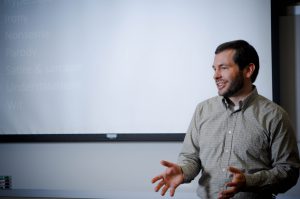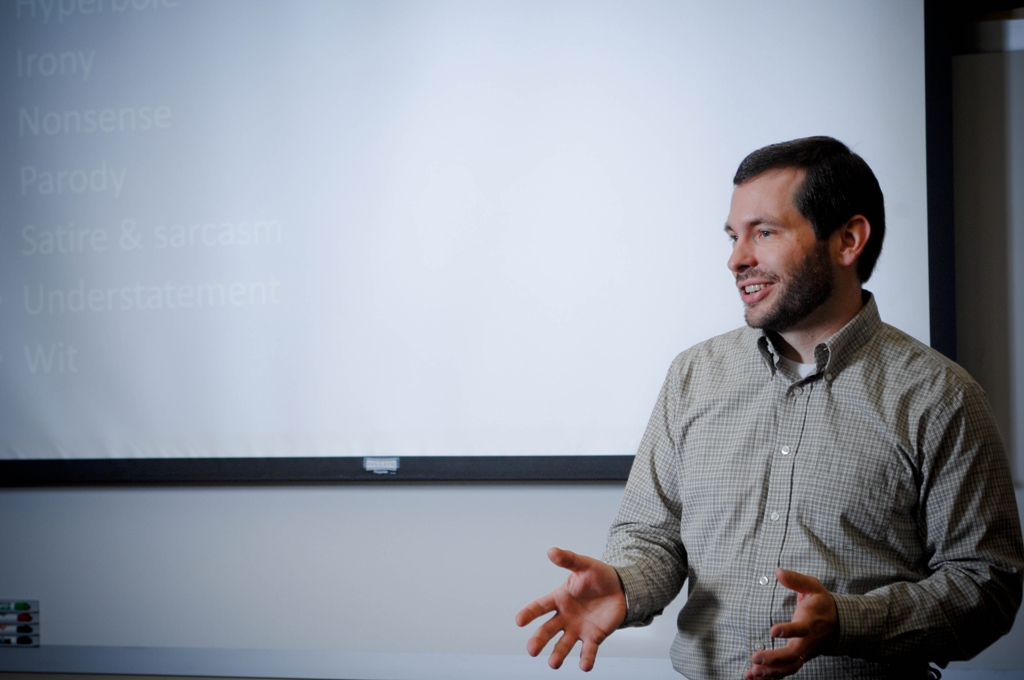For Dr. Michael Lovorn, humor is more than just a diversion or a way to blow off steam—it’s a cornerstone of sophisticated, higher-order thinking.
“I believe humor is a big part of human development,” says Lovorn, an assistant professor of social studies education at The University of Alabama, who has spent more than a decade researching the use of humor in the classroom. “It’s one of the things that separates us from other life forms.”
It’s also an invaluable teaching tool, he says, and one that more educators would do well to embrace.

“Engagement is the key to successful learning, and humor is a means by which we can engage our audience,” he says. “It can help with motivation and student performance. Many students mention my humor approach in classroom evaluations. So, personally, I know there’s value in it.”
THE ‘FUNNY GUY’
Lovorn’s interest in classroom humor took root during his first teaching job in the 1990s, when he faced the challenge of conducting classes in noisy, overcrowded spaces. “I tried to keep the students’ attention with wordplays, improvs, humorous voices,” he says. “As the years passed, I got to be quite skilled at it, and they started recognizing me as the funny guy.”
As he worked toward his master’s and doctoral degrees in the ensuing years, humor became the target of his research, both as a way of presenting material and as a means of classroom management. “If you’ve got [students’] attention, they are less likely to cause significant disruption,” he says. Not only does humor extend students’ attention span and encourage interactivity, he adds, it also can help make course material fresh and relevant.
And, contrary to popular belief, it can help teachers manage their classrooms by proactively addressing students’ behavioral patterns. “One student can completely alter the dynamic of a classroom,” he says. “In any classroom, you have one or two students who take the alpha position. They’re often the catalysts, and then there’s a middle group, the ones who really feed off the response they get from the alpha figure.” If a teacher can connect with that alpha student, he says, then by extension, he or she can more effectively relate to, and influence, others.
Brad Lannom, a UA graduate student in secondary education who has taken two of Lovorn’s courses, says the professor’s approach—jokes, funny stories, impromptu cartoon sketches—helps enliven class time and bolster participation. “I think it’s very effective,” Lannom says. “It loosens up the mood and gets the class more willing to talk, more relaxed and open to what he’s saying.”
To date, most of Lovorn’s findings have come from qualitative interviews with educators, both at K-12 and college levels. “Humor is subjective, and it’s not readily quantifiable,” he says. “A good deal of it has to do with self-perception.” During these interviews, he asks a series of open-ended questions aimed at pinpointing the reasons why teachers do or don’t employ humor in their classrooms, the sources of their material, the techniques they prefer, and the effects they’ve seen on students.
Although Lovorn’s research methods began informally, they’ve become more structured in the intervening years. He’s currently developing a Likert-style survey, in which respondents select their level of agreement with provided statements, in hopes of identifying trends and strategies in the use of humor that could be widely applied in the future. He also plans to devote more time to student-centered research to learn more about what they respond to and what they don’t—particularly secondary students, on whom, he says, there has been virtually no research to date.
So far, the biggest surprise in his findings has been what he calls the “humor paradox.” “We say we value humor, but we seldom put our money where our mouth is,” says Lovorn, who has published articles on humor in journals like California Educator and The Journal of Education and Human Development. “We think that if laughter is occurring, something must be askew. In the workplace, it’s commonly squelched.” Compounding the problem in the education field, he adds, is the emphasis on gauging performance in concrete, measurable ways. “I think that’s one of the endemic problems: [Teachers] are under so much pressure to perform in terms of test scores, and they’ll say they don’t have time for humor,” he says.
LET OUT THE LAUGHS
Lovorn believes it’s important to reverse that way of thinking, largely because he expects humor to play an increasingly vital role in teacher-student communication. “I’ve seen a trend toward humor being accepted, brought on by millennials,” he says. “That trend is not going away. If you are incapable of using some sort of humor, you will lose a lot of them. They place a high value on it.”

Lovorn also stresses the difference between humor with a goal in mind and humor for no clear reason. “This is not for entertainment’s sake; it is for engagement’s sake,” he says. “Teaching with humor should somehow be measurable.” Though difficult to quantify, results become tangible in other ways: motivation, engagement, students’ attitudes and perceptions toward school and course work, and yes, even improved test scores.
As his research progresses, Lovorn hopes to explore humor as a means of presenting history and the social sciences. “I’d like to look at how people have used humor to deal with historical events and eras,” he says. “Humor has really abounded during hard times—for example, stand-up comedy exploded in the 1970s. People have to have an outlet.”
